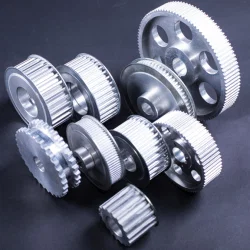Overview of Belt Pulleys
2024-06-15
A belt pulley is a key component in a motorcycle's drivetrain, particularly in models that use belt-driven systems instead of chain or shaft drives. Here’s an in-depth look at belt pulleys:
Overview of Belt Pulleys
1. Function: Belt pulleys transmit power from the motorcycle's engine to the rear wheel, allowing the bike to move. They work in conjunction with a belt, usually made of reinforced rubber, to transfer rotational force smoothly and efficiently.
2. Components:
- Drive Pulley (Front Pulley): Attached to the engine output shaft.
- Driven Pulley (Rear Pulley): Mounted on the rear wheel.
- Belt: Connects the drive pulley to the driven pulley.
Types of Belt Pulleys
1. Stock Pulleys: Original equipment manufacturer (OEM) pulleys designed specifically for a motorcycle model. They are optimized for standard performance and longevity.
2. Aftermarket Pulleys: These can be performance-oriented, offering benefits like reduced weight or improved materials for better durability and efficiency.
Materials Used
1. Aluminum: Lightweight and commonly used in both OEM and aftermarket pulleys. Often coated or anodized for increased durability.
2. Steel: Heavier but extremely durable. Suitable for high-stress applications.
3. Composite Materials: Sometimes used in high-performance applications for reduced weight and increased strength.
Benefits of Belt Drives
1. Low Maintenance: Belts require less frequent adjustments and lubrication compared to chains.
2. Smooth Operation: Belts provide a quieter and smoother ride.
3. Long Life: Belts and pulleys can last longer than chains and sprockets if maintained properly.
4. Cleanliness: Belts do not require lubrication, resulting in a cleaner system without the mess of chain oil.
Installation and Maintenance
1. Installation: Replacing a belt pulley generally requires:
- Removing the old belt and pulleys.
- Installing the new pulleys and aligning them properly.
- Tensioning the belt to the manufacturer's specifications.
2. Maintenance Tips:
- Regular Inspection: Check for wear, cracks, or damage on the pulleys and belt.
- Tension Adjustment: Ensure the belt is neither too tight nor too loose, as incorrect tension can lead to premature wear or slippage.
- Cleanliness: Keep the pulleys and belt clean from debris and dirt.
- Alignment: Ensure the pulleys are correctly aligned to prevent uneven wear and noise.
Buying Belt Pulleys
1. Compatibility: Ensure the pulley is compatible with your motorcycle model and the existing belt drive system.
2. Quality: Opt for high-quality materials, especially if purchasing aftermarket pulleys.
3. Vendor Reputation: Purchase from reputable dealers or manufacturers to ensure reliability and customer support.
4. Performance Needs: Consider your riding style and performance needs when selecting pulleys. Performance pulleys can enhance acceleration and efficiency but might be more expensive.
Where to Find Belt Pulleys
1. Official Dealerships: Best for OEM parts that guarantee fit and function.
2. Online Retailers: Websites like RevZilla, BikeBandit, and Partzilla offer a variety of options for different motorcycle models.
3. Specialty Shops: Some shops specialize in custom or high-performance parts.
4. Motorcycle Forums and Communities: Often, fellow riders sell used parts or recommend reliable sources.
Brands and Manufacturers
1. OEM Brands: Harley-Davidson, Yamaha, Honda, and other major motorcycle manufacturers.
2. Aftermarket Brands: Companies like Gates, BDL (Belt Drives Ltd.), and Vance & Hines offer high-quality belt pulleys.
Conclusion
Belt pulleys are a crucial part of belt-driven motorcycles, providing smooth and efficient power transfer from the engine to the rear wheel. Understanding their function, maintenance needs, and how to choose the right components will help ensure your motorcycle runs smoothly and reliably. If you need specific recommendations or further details, feel free to ask!



